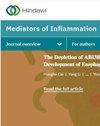利用多机器学习算法识别和验证涉及类风湿性关节炎的新型生物标记物:硅内和体内研究
IF 4.4
3区 医学
Q2 CELL BIOLOGY
引用次数: 0
摘要
背景。类风湿性关节炎(RA)仍然是最常见的慢性关节疾病之一。然而,由于 RA 患者的异质性,目前仍没有可靠的诊断和治疗生物标志物用于 RA 的诊断和治疗。方法。我们分别从基因表达总库(Gene Expression Omnibus)和癌症基因组图谱(The Cancer Genome Atlas)数据库中检索了与 RA 相关的数据集和泛癌症信息数据集。采用 GSE12021、GSE29746、GSE55235、GSE55457、GSE77298 和 GSE89408 的六种基因表达谱和相应的临床信息,对 RA 进行差异表达基因分析、富集分析和免疫成分差异分析。四种机器学习算法(包括 LASSO、RF、XGBoost 和 SVM)被用于识别 RA 相关的生物标记物。此外,还采用了无监督聚类分析来解读 RA 的异质性。构建并验证了基于四个特征的提名图,可从正常组织中特异性诊断出 RA 和骨关节炎(OA)。因此,RA-HFLS 细胞被用来研究 CRTAM 在 RA 中的生物学作用。此外,还比较了 CRTAM 和其他 RA 经典生物标记物的诊断效果和生物学作用。结果显示免疫和基质成分在 RA 中高度富集。在 RA 组织中,与趋化因子和 Th 细胞相关的特征被显著激活。发现并验证了四个有前景的新型生物标记物,包括 CRTAM、PTTG1IP、ITGB2 和 MMP13,它们可作为 RA 的新型治疗和诊断靶标。基于这四个特征的提名图可能有助于区分和诊断RA,在训练队列(AUC = 0.894)和测试队列(AUC = 0.843)中都达到了令人满意的效果。研究发现了两种不同亚型的 RA 患者,这进一步验证了这四个特征可能参与了免疫浸润过程。此外,敲除CRTAM能显著抑制RA细胞系的增殖和侵袭能力,因此可作为一种新的治疗靶点。与以往的生物标记物(包括MMP3、S100A8、S100A9、IL6、COMP、LAG3和ENTPD1)相比,CRTAM对RA的诊断效果更佳。从机制上讲,CRTAM 还可能通过免疫功能障碍、脂肪酸代谢和基因组不稳定性参与多种癌症亚型的进展。结论CRTAM、PTTG1IP、ITGB2和MMP13在RA组织中高表达,可能通过恶化免疫功能紊乱状态而成为关键的诊断和治疗靶点。此外,CRTAM 可能会通过免疫信号助长癌症进展,尤其是在 RA 患者中。本文章由计算机程序翻译,如有差异,请以英文原文为准。
Identification and Verification of Novel Biomarkers Involving Rheumatoid Arthritis with Multimachine Learning Algorithms: An In Silicon and In Vivo Study
Background. Rheumatoid arthritis (RA) remains one of the most prevalent chronic joint diseases. However, due to the heterogeneity among RA patients, there are still no robust diagnostic and therapeutic biomarkers for the diagnosis and treatment of RA. Methods. We retrieved RA-related and pan-cancer information datasets from the Gene Expression Omnibus and The Cancer Genome Atlas databases, respectively. Six gene expression profiles and corresponding clinical information of GSE12021, GSE29746, GSE55235, GSE55457, GSE77298, and GSE89408 were adopted to perform differential expression gene analysis, enrichment, and immune component difference analyses of RA. Four machine learning algorithms, including LASSO, RF, XGBoost, and SVM, were used to identify RA-related biomarkers. Unsupervised cluster analysis was also used to decipher the heterogeneity of RA. A four-signature-based nomogram was constructed and verified to specifically diagnose RA and osteoarthritis (OA) from normal tissues. Consequently, RA-HFLS cell was utilized to investigate the biological role of CRTAM in RA. In addition, comparisons of diagnostic efficacy and biological roles among CRTAM and other classic biomarkers of RA were also performed. Results. Immune and stromal components were highly enriched in RA. Chemokine- and Th cell-related signatures were significantly activated in RA tissues. Four promising and novel biomarkers, including CRTAM, PTTG1IP, ITGB2, and MMP13, were identified and verified, which could be treated as novel treatment and diagnostic targets for RA. Nomograms based on the four signatures might aid in distinguishing and diagnosing RA, which reached a satisfactory performance in both training (AUC = 0.894) and testing (AUC = 0.843) cohorts. Two distinct subtypes of RA patients were identified, which further verified that these four signatures might be involved in the immune infiltration process. Furthermore, knockdown of CRTAM could significantly suppress the proliferation and invasion ability of RA cell line and thus could be treated as a novel therapeutic target. CRTAM owned a great diagnostic performance for RA than previous biomarkers including MMP3, S100A8, S100A9, IL6, COMP, LAG3, and ENTPD1. Mechanically, CRTAM could also be involved in the progression through immune dysfunction, fatty acid metabolism, and genomic instability across several cancer subtypes. Conclusion. CRTAM, PTTG1IP, ITGB2, and MMP13 were highly expressed in RA tissues and might function as pivotal diagnostic and treatment targets by deteriorating the immune dysfunction state. In addition, CRTAM might fuel cancer progression through immune signals, especially among RA patients.
求助全文
通过发布文献求助,成功后即可免费获取论文全文。
去求助
来源期刊

Mediators of Inflammation
医学-免疫学
CiteScore
8.70
自引率
0.00%
发文量
202
审稿时长
4 months
期刊介绍:
Mediators of Inflammation is a peer-reviewed, Open Access journal that publishes original research and review articles on all types of inflammatory mediators, including cytokines, histamine, bradykinin, prostaglandins, leukotrienes, PAF, biological response modifiers and the family of cell adhesion-promoting molecules.
 求助内容:
求助内容: 应助结果提醒方式:
应助结果提醒方式:


